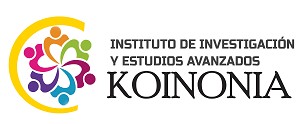Estabilidad de miniimplantes en el paladar como método de anclaje. Revisión narrativa
Resumen
Actualmente los dispositivos de anclaje esquelético temporal palatinos se han convertido en una herramienta importante en los tratamientos de ortodoncia y han creado un cambio en la biomecánica y el anclaje, obteniendo ahora movimientos antes limitados; por ello esta revisión bibliográfica tiene como objetivo evaluar la estabilidad de miniimplantes en el paladar como método de anclaje mediante una revisión narrativa e informativa, considerando investigaciones sobre el tema, en buscadores científicos como PubMed, Scopus, Portal regional BVS, Ovid, Taylor & Francis Online y Web of Science; donde se demuestra que paladar es un hueso con adecuada altura y espesor óseo para la colocación de miniimplantes, debido a sus características morfológicas y anatómicas especialmente en las zonas del paladar medioanterior y paramediano.
Descargas
Citas
Alkadhimi, A., & Al-Awadhi, E. (2018). Miniscrews for orthodontic anchorage: a review of available systems. Journal of Orthodontics, 45(2), 102–114. https://doi.org/10.1080/14653125.2018.1443873
Benaissa, A., Merdji, A., Bendjaballah, M., Ngan, P., & Mukdadi, O. (2020). Stress influence on orthodontic system components under simulated treatment loadings. Computer Methods and Programs in Biomedicine, 195, (aprox.7 p). https://doi.org/10.1016/j.cmpb.2020.105569
Copello, F., Brunetto, D., Elias, C., Pithon, M., Coqueiro, R., Castro, A., & Sant’Anna, F. (2021). Miniscrew-assisted rapid palatal expansion (Marpe): How to achieve greater stability. in vitro study. Dental Press Journal of Orthodontics, 26(1), 1–23. https://doi.org/10.1590/2177-6709.26.1.e211967.oar
Erbay, F., Oflaz, E., Bugra, E., Orhan, M., & Demir, T. (2020). Effect of cortical bone thickness and density on pullout strength of mini-implants: An experimental study. American Journal of Orthodontics and Dentofacial Orthopedics, 157(2), 178–185. https://doi.org/10.1016/j.ajodo.2019.02.020
Ghafari, J., & Ammoury, M. (2020). Overcoming compact bone resistance to tooth movement. American Journal of Orthodontics and Dentofacial Orthopedics, 158(3), 343–348. https://doi.org/10.1016/j.ajodo.2020.02.006
Han, S., Bayome, M., Lee, J., Lee, Y., & Song, H. (2012). Evaluation of palatal bone density in adults and adolescents for application of skeletal anchorage devices. Angle Orthodontist, 82(4). https://doi.org/10.2319/071311-445.1
Holm, M., Jost, P., Mah, J., & Bumann, A. (2016). Bone thickness of the anterior palate for orthodontic miniscrews. Angle Orthodontist, 86(5), 826–831. https://doi.org/10.2319/091515-622.1
Hotta, A., Uchida, Y., Namura, Y., Inaba, M., & Motoyoshi, M. (2020). Finite element analysis of stress caused by palatal orthodontic anchor screws. Journal of Oral Science, 62(3), 318–321. https://doi.org/10.2334/josnusd.19-0088
Ichinohe, M., Motoyoshi, M., Inaba, M., Uchida, Y., Kaneko, M., Matsuike, R., & Shimizu, N. (2019). Risk factors for failure of orthodontic mini-screws placed in the median palate. Journal of Oral Science, 61(1), 13–18. https://doi.org/10.2334/josnusd.17-0377
Kyung, H., Ly, N., & Hong, M. (2017). Orthodontic skeletal anchorage: Up-to-date review. Orthodontic Waves, 76(3), 123–132. https://doi.org/10.1016/j.odw.2017.06.002
Lee, J., Doo, H., Park, Y., Kyung, S., & Kim, T. (2014). The efficient use of midpalatal miniscrew implants. Angle Orthodontist, 74(5), 711–714.
Lee, R., Moon, W., & Hong, C. (2017). Effects of monocortical and bicortical mini-implant anchorage on bone-borne palatal expansion using finite element analysis. American Journal of Orthodontics and Dentofacial Orthopedics, 151(5), 887–897. https://doi.org/10.1016/j.ajodo.2016.10.025
Lyu, X., Guo, J., Chen, L., Gao, Y., Liu, L., Pu, L., Lai, W., & Long, H. (2020). Assessment of available sites for palatal orthodontic mini-implants through cone-beam computed tomography. Angle Orthodontist, 90(4), 516–523. https://doi.org/10.2319/070719-457.1
Masume, J., Farzaneh, K., & Arman, S. (2015). Relationship Between the Thickness of Cortical Bone at Maxillary Mid-palatal Area and Facial Height Using CBCT. The Open Dentistry Journal, 9, 287–291. https://pubmed.ncbi.nlm.nih.gov/26464597/
Oh, S., Lee, S., Choi, J., Ahn, H., Kim, S., & Nelson, G. (2021). Geometry of anchoring miniscrew in the lateral palate that support a tissue bone borne maxillary expander affects neighboring root damage. Scientific Reports, 11(1), 1–10. https://doi.org/10.1038/s41598-021-99442-2
Oh, S., Lee, S., J, C., Kim, S., Hwang, E., & Nelson, G. (2021). Quantitative cone-beam computed tomography evaluation of hard and soft tissue thicknesses in the midpalatal suture region to facilitate orthodontic mini-implant placement. Korean Journal of Orthodontics, 51, 260–269. https://pubmed.ncbi.nlm.nih.gov/34275882/
Poon, Y., Chang, H., Tseng, Y., Chou, S., Cheng, J. H., Liu, P., & Pan, C. (2015). Palatal bone thickness and associated factors in adult miniscrew placements: A cone-beam computed tomography study. Kaohsiung Journal of Medical Sciences, 31(5), 265–270. https://doi.org/10.1016/j.kjms.2015.02.002
Ryu, J., Park, J., Vu, T., Thu, T., Bayome, M., Kim, Y., Kook, Y., Park, J., Vu, T., Thu, T., Bayome, M., Kim, Y., & Kook, Y. (2012). Palatal bone thickness compared with cone-beam computed tomography in adolescents and adults for mini-implant placement. American Journal of Orthodontics and Dentofacial Orthopedics, 142(2), 207–212. https://doi.org/10.1016/j.ajodo.2012.03.027
Suteerapongpun, P., Wattanachai, T., Janhom, A., Tripuwabhrut, P., & Jotikasthira, D. (2018). Quantitative evaluation of palatal bone thickness in patients with normal and open vertical skeletal configurations using cone-beam computed tomography. Korean Academy of Oral and Maxillofacial Radiology, 48, 51–57. https://pubmed.ncbi.nlm.nih.gov/29581950/
Tirado, A., Sarai, J., Silva, A., & Gutierrez, J. (2019). Investigaciones originales [Original research]. Acta Odontologica Colombiana, 9(1), 24–35. https://revistas.unal.edu.co/index.php/actaodontocol/article/view/78843/pdf
Uesugi, S., Kokai, S., Kanno, Z., & Ono, T. (2017). Stability of secondarily inserted orthodontic miniscrews after failure of the primary insertion for maxillary anchorage: Maxillary buccal area vs midpalatal suture area. American Journal of Orthodontics and Dentofacial Orthopedics, 153(1), 54–60. https://doi.org/10.1016/j.ajodo.2017.05.024
Vidalón, J., Liñan, C., Tay, L., Meneses, A., & Lagravère, M. (2021). Evaluation of the palatal bone in different facial patterns for orthodontic mini-implants insertion: A cone-beam computed tomography study. Dental Press Journal of Orthodontics, 26(1), 1–29. https://doi.org/10.1590/2177-6709.26.1.e2119204.oar
Wilmes, B., Ludwig, B., Vasudavan, S., Niemkermper, M., & Drescher, D. (2016). The T-Zone : Median vs . Paramedian Insertion of Palatal Mini-Implants. L(9), 543–551. https://pubmed.ncbi.nlm.nih.gov/27809213/
Winsauer, H., Vlachojannis, C., Bumann, A., Vlachojannis, J., & Chrubasik, S. (2014). Paramedian vertical palatal bone height for mini-implant insertion : a systematic review. European Journal of Orthodontics, 36(December 2012), 541–549. https://doi.org/10.1093/ejo/cjs068
Derechos de autor 2022 Gabriela Estefanny Tapia-Figueroa, Miriam Verónica Lima-Illescas

Esta obra está bajo licencia internacional Creative Commons Reconocimiento-NoComercial-CompartirIgual 4.0.
CC BY-NC-SA : Esta licencia permite a los reutilizadores distribuir, remezclar, adaptar y construir sobre el material en cualquier medio o formato solo con fines no comerciales, y solo siempre y cuando se dé la atribución al creador. Si remezcla, adapta o construye sobre el material, debe licenciar el material modificado bajo términos idénticos.
OAI-PMH URL: https://cienciamatriarevista.org.ve/index.php/cm/oai














